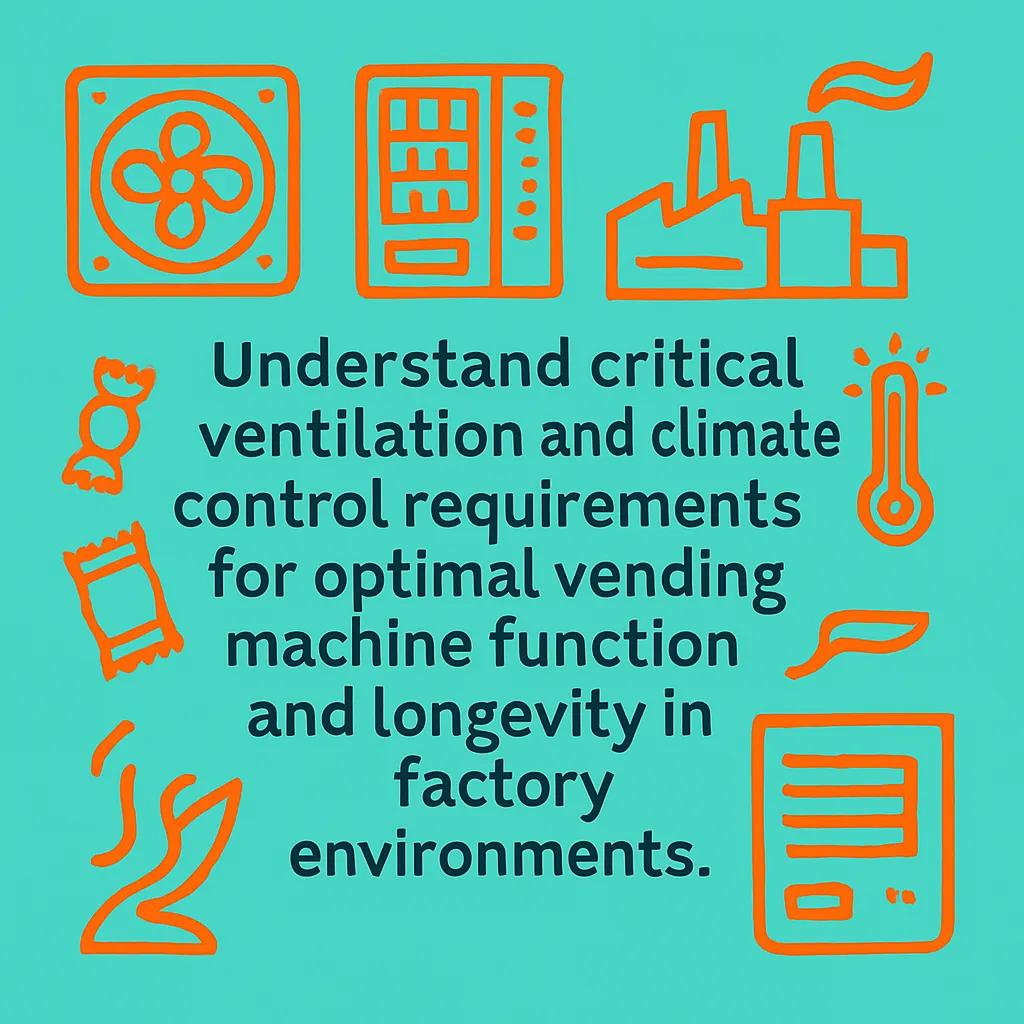Ventilation Requirements for Vending Machines in Factories
Understand critical ventilation and climate control requirements for optimal vending machine function and longevity in factory environments.
Back to Vending for Manufacturing ResourcesUnderstand critical ventilation and climate control requirements for optimal vending machine function and longevity in factory environments.
Back to Vending for Manufacturing ResourcesFactories present unique environmental challenges for vending machines. Proper ventilation and climate control are not just recommended, they are essential for machine longevity, product quality, and operational efficiency.
![]() Prevents overheating and extends machine lifespan
Prevents overheating and extends machine lifespan
![]() Maintains ideal product temperature and freshness
Maintains ideal product temperature and freshness
![]() Reduces maintenance needs and improves reliability
Reduces maintenance needs and improves reliability

In the demanding environment of a factory, vending machines face unique challenges that can significantly impact their performance and longevity. Unlike typical office settings, industrial spaces often contend with fluctuating temperatures, high humidity, dust, and airborne particulates. Addressing these factors through proper ventilation and strategic placement is paramount to ensuring your vending services operate effectively and reliably.
Modern vending machines, especially those offering refrigerated drinks and fresh food, rely on efficient cooling systems. Without adequate airflow, these systems can easily overheat, leading to increased energy consumption, frequent breakdowns, and a shortened lifespan for critical components. Proper ventilation ensures that heat generated by the machine's internal mechanics can dissipate efficiently, maintaining optimal operating temperatures and significantly extending the life of your investment. It's not just about keeping the products cold, but about preserving the machine itself in challenging conditions, a topic frequently discussed when considering equipment durability for industrial vending.
High temperatures and humidity can compromise the quality and safety of vending machine products. Drinks can become less refreshing, snacks can spoil faster, and in severe cases, condensation can lead to mold or bacterial growth, posing health risks. Effective ventilation helps to regulate the internal climate of the machine, ensuring that food and beverages are kept at their ideal serving temperatures, preserving taste, freshness, and safety for your factory workers. This directly impacts employee satisfaction and productivity, supporting broader goals of vending services for manufacturing plants.
Careful consideration of where vending machines are placed within a factory is crucial. Avoid areas directly exposed to heat sources like furnaces, direct sunlight through large windows, or areas with poor air circulation. Ensure there is ample space around the machine, typically 4-6 inches on all sides, for proper airflow. Regular cleaning of intake and exhaust vents is also vital to prevent dust and debris from obstructing airflow and impairing cooling efficiency. When selecting machines, exploring robust models suitable for these conditions is essential, as detailed in guides like best vending machines for industrial facilities. Integrating these practices into your factory setup will help maximize the benefits of on-site vending, providing convenient and reliable refreshment options for your workforce in even the toughest environments.
Proper ventilation prevents overheating, extends machine lifespan, ensures product quality, and avoids potential safety hazards like condensation or mold growth in industrial settings.
Temperature extremes, high humidity, dust, airborne particles, and chemical fumes can all negatively affect vending machine operation and longevity.
Inadequate airflow causes internal components to run hotter, increasing wear and tear, leading to premature failures, and shortening the machine's overall service life.
While specific ranges vary by machine type, generally maintaining ambient temperatures below 85°F (29°C) is ideal to prevent strain on cooling systems and ensure product integrity.
Strategic placement away from heat sources, ensuring sufficient clearance around the machine, regular cleaning of vents, and potentially installing auxiliary fans or air conditioning in the immediate area.
High humidity can lead to condensation inside machines, corrode electrical components, and damage product packaging, especially for refrigerated items.
While convenient for workers, close proximity to production lines often means higher temperatures, dust, and vibration, necessitating extra ventilation considerations or alternative placement.
Regular inspection and cleaning of air intake and exhaust vents, dust filters (if present), and condenser coils are essential to maintain optimal airflow.
Yes, airborne contaminants like dust or chemical odors can infiltrate the machine, potentially affecting the taste, smell, or hygiene of dispensed food and beverages.
Most manufacturers recommend at least 4-6 inches of clearance on all sides, especially the back, to allow for adequate heat dissipation and airflow.